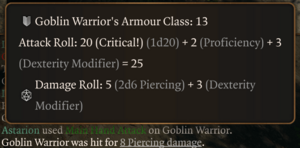More actions
AHHHHHH I GIVE UP WHY DOES SECOND STORY WORK SEEM TO REDUCE FALL DAMAGE BY LIKE 4x RATHER THAN 2X AHHHHH
Falling damage is the Damage a creature suffers to their Hit points, in the form of ![]() Bludgeoning damage, when they fall a sufficient distance. Falling damage is most commonly caused by Jumping from heights or being Shoved or Thrown from them.
Bludgeoning damage, when they fall a sufficient distance. Falling damage is most commonly caused by Jumping from heights or being Shoved or Thrown from them.
Falling damage formula
Baldur's Gate 3 does not use the standard D&D ruleset for falling damage, in which creatures take 1d6 damage for every 10ft they fall, and instead uses it's own formula in which the damage is consistent and scales more discretely as the height of the fall increases.
The amount of damage taken from falls scales linearly based on the height of the fall, dealing a percentage of the creatures maximum health:
- Falls of less than
 4 m / 13 ft deal no damage.
4 m / 13 ft deal no damage. - Falls over
 4 m / 13 ft deal damage starting at roughly 2% of the creatures maximum health and increasing by an additional 1% for every additonal
4 m / 13 ft deal damage starting at roughly 2% of the creatures maximum health and increasing by an additional 1% for every additonal  0.2 m / 1 ft fallen. [Needs Verification]
0.2 m / 1 ft fallen. [Needs Verification] - Falls become lethal at heights of around
 23 m / 77 ft or if a creature falls out of the playable game area.
23 m / 77 ft or if a creature falls out of the playable game area. - Creatures afflicted with will take and additional 1d8
 Psychic damage.
Psychic damage.
When jumping from a height great enough to deal damage, a tooltip will display the damage the creature will suffer if they jump to the targeted location. If the damage would be sufficient to kill the creature the text "Dead" will be displayed instead.
Example
A creature that falls from a height of ![]() 5.4 m / 18 ft, with no resistance to falling damage, would be expected to take damage equal to 2% of their max health + 1% for every additional
5.4 m / 18 ft, with no resistance to falling damage, would be expected to take damage equal to 2% of their max health + 1% for every additional ![]() 0.2 m / 1 ft of height after damage begins, in this case giving us 2% + 7% or around 9% of a creatures max hit points from a
0.2 m / 1 ft of height after damage begins, in this case giving us 2% + 7% or around 9% of a creatures max hit points from a ![]() 5.4 m / 18 ft fall.
5.4 m / 18 ft fall.
Prone
Falls can also cause creatures to be knocked Prone when they land. A fall will always cause a creature to fall prone
Falling damage resistance and immunity
There are numerous sources of Resistance and Immunity to fall damage, some temporary from spells and consumables and some permanent from certain class or passive features.
Any source of resistance to bludgeoning damage will grant the creature resistance to falling damage and passive features such as Magical Plate will also reduce the damage, but in addition there are also sources that specifically provide resistance to only falling damage. Resistance to falling damage will correctly update the estimated damage displayed when jumping from heights, while resistance to bludgeoning damage and general damage reduction will not be reflected in the estimate.
Resistance
- : Class feature granted to rogues at level 3 if they choose the Thief subclass.
- :
 Reaction granted to monks at level 4.
Reaction granted to monks at level 4. - : Variant of Enhance Ability availiable to bards, clerics, druids, and sorcerers at level 3 or from
 The Graceful Cloth.
The Graceful Cloth. - : Passive feature unique to Cats.
Immunity
- : Condition granted by ,
 Potion of Feather Fall,
Potion of Feather Fall,  Scroll of Feather Fall, and
Scroll of Feather Fall, and  Corvid Token.
Corvid Token. - : Passive feature granted by
 Nyrulna.
Nyrulna. - : Condition granted in the Astral Plane and the Shadowfell.
- : Passive feature unique to Poltergeists.


